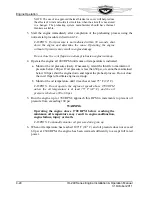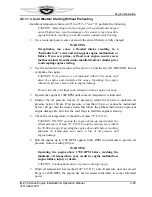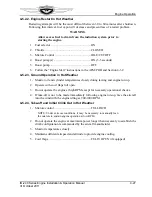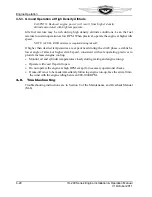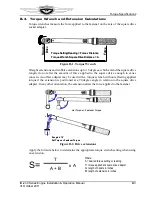
IO-240 Series Engine Installation & Operation Manual
4-21
31 October 2011
Engine Operation
4-5. Engine Operation in Abnormal Environments
The anticipated types of abnormal environments are:
•
Extreme cold weather
•
Extreme hot weather
•
High density altitude ground operation
4-5.1. Engine Operation in Extreme Cold
Engine starting during extreme cold weather is more difficult than in moderate
temperatures. Cold soaking causes the oil to become thicker (more viscous), making it
difficult for the starter to crank the engine which results in slow cranking speeds and an
abnormal drain on the battery capacity. At low temperatures, aviation gasoline does not
vaporize readily, further complicating the starting procedure.
WARNING
Over priming can cause a flooded intake resulting in a
“hydraulic lock” event and subsequent engine malfunction or
failure. If you over-prime (flood) the engine, make certain that
excess fuel has drained from the intake manifold and/or
cylinder prior to attempting engine start.
CAUTION: Use an external power source when attempting to start
aircraft engine in cold weather. Attempting to start an engine with a
partially discharged aircraft battery may result in damage to the
starter relay or possible engine kick-back resulting in a broken
starter adapter clutch spring
False starting (failure to continue running after starting) often results in condensation on
spark plug electrodes. This moisture can freeze and must be eliminated either by
preheating the engine or removing and cleaning the spark plugs.
Engine preheating and an auxiliary power unit (APU) are required to facilitate engine
starting when the engine has been exposed to temperatures below 20º F (-7° C) for more
than two hours. Refer to Section 4-5.1.1 and the AFM/POH for specific instructions. At
ambient temperatures between 20º and 40º F (-7º and 4º C), refer to Section 4-5.1.1.3.
WARNING
Failure to properly preheat a cold-soaked engine may result in
oil congealing within the engine, oil hoses, and oil cooler with
subsequent loss of oil flow, possible internal damage to the
engine, and subsequent engine failure.
Superficial application of preheat to a cold soaked engine can
cause damage to the engine. An inadequate application of
preheat may warm the engine enough to permit starting but
will not decongeal oil in the sump, lines, cooler, filter, etc.
Congealed oil in these areas require considerable preheat. The
engine may start and appear to run satisfactorily, but can be
damaged from lack of lubrication due to the congealed oil
Summary of Contents for IO-240-A
Page 145: ......
Page 146: ...www continentalmotors aero ...


















